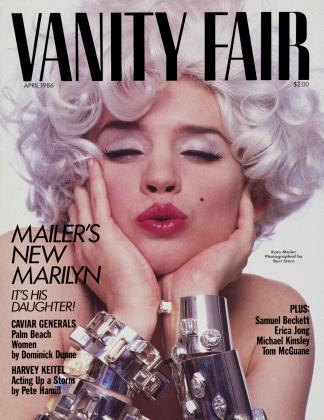Sign In to Your Account
Subscribers have complete access to the archive.
Sign In Not a Subscriber?Join NowEl Morocco’s Night Watch
A glimpse of Garry Winogrands underexposed work from the fifties
■ o one can say for sure just when ■ Garry Winogrand brought his cam■ era and his gaze to New York’s El ■ Morocco Club. The best guess is ■ 1955. At that time, El Morocco was quite a club, perhaps theclub. Outside, along East Fifty-fourth Street, there were family chauffeurs in the double-parked cars; inside, vintage champagne in the buckets. Manhattan’s aristocracy—the mix of old money and fresh stars first tossed together in the speakeasies—huddled in the zebrastriped banquettes. For every show-biz face made recognizable by Life and Look, there were two or three of the kind described by John O’Hara in his short stories: clean faces of men who were heading to Paris, who had been to Yale. The band was the Charles Holden and Freddy Alonso Orchestra, the women wore satin, the dancing was hot and close. If you felt blase, you could count on the waiter to keep bringing highballs deep into the night.
Winogrand had been taking pictures for only six or seven years when he photographed the scene at El Morocco. After a few of these photos were shown in 1963 at the Museum of Modem Art, he banished them to a box in the closet,
there to remain all but unknown even to professionals intimate with his work. Perhaps after the critics had handed him the baton first carried by Cartier-Bresson and Brassal, he came to think these pictures easy and amateurish. Now, two years after his death and a year and a half before a planned Winogrand retrospective at MoMA, there is at last a glimpse; a number of the El Morocco pictures are included this month in a show titled “Little Known Photographs by Garry Winogrand” at the Fraenkel Gallery in San Francisco. They tell us too much about a watershed artist’s nascent vision—and about their time—to have remained out of sight for so long.
In his little-known El Morocco photographs (now on view at San Francisco’s Fraenkel Gallery), Garry Winogrand documented the deadpan dramas of the chic club of the moment—where a bosomy bongo player created as much spectacle as a famous face.
Winogrand’s camera caught Truman Capote (who would soon write Breakfast at Tiffany’s) in a remarkable picture that tells more than he knew.
Already in these pictures you see signs of Winogrand’s casual complexity—the formal rhythms established by pale flesh and black-tie, the hands and glances in counterpoint, the deadpan drama he seems to capture just at the perfect moment. There is also the uncanny, spectral presence of Winogrand himself, maneuvering invisibly among the tables and around the dance floor. It is as it would be with his greatest works, those “Public Relations’’ photos of cocktail parties, press conferences, and art openings from the late sixties and early seventies. You wonder how he got so close (to a crowded table or a fox-trotting couple) yet remained so unobtrusive. What these pictures don’t have is the nasty self-consciousness that informs the “Public Relations” photos, that gives them their acidsour flavor. Winogrand had come to recognize that social life by the late sixties was largely costume, existing only to be photographed. At El Morocco, he was still wide-eyed and vulnerable and fascinated.
And looking at the pictures, you’re fascinated too. There’s a trim and elegant Joe DiMaggio, drinking coffee, his face and awkwardly placed left arm asking, “Why haven’t I left yet?” (Marilyn Monroe had just left him.) There are terrific photos, both boozy and bubbly, of couples dancing. It’s the faces, not the legs, that interested Winogrand—the distraction, but also the sweet abandon. A picture of a bongo player is campy-funny, and more. At El Morocco, as at so
many night spots, guests sought the spectacle of the primitive—pulsing heat at a cool distance. Winogrand’s photo captures this, shows how the refined clubgoer (seated comfortably, legs crossed) consumes with his gaze.
One of the best pictures is of Truman Capote. He’s in a tux, and appears to be table-hopping. At the moment Winogrand chose to snap, however, Capote looks to be headed nowhere—those at the table he’s standing behind don’t know he’s there. The riveting detail, though, is his half-open mouth. He might be giggling his giggle, or maybe he’s delivering a fast, deadly wisecrack to the balding eminence seated directly in front of him. But looking at this picture across time, you see his mouth frozen open in a silent Munch scream, as if he’s suddenly glimpsed how all that is surrounding him will eventually strangle him.
Yet this isn’t the saddest thing about the El Morocco pictures. More depressing is what they tell us about nightlife today. Photographs of the club scene form a full-blown genre now—visit the galleries, or leaf through Details or Interview. Looking at these pictures, you see that the fascinated gaze now belongs not to the photographer but to the subject. In the Palladium’s Michael Todd Room, the most interesting faces are masks in search of the flash. At El Morocco, you didn’t need a camera to know which way the wind was blowing.
Gerald Marzorati
 View Full Issue
View Full Issue


















Subscribers have complete access to the archive.
Sign In Not a Subscriber?Join Now